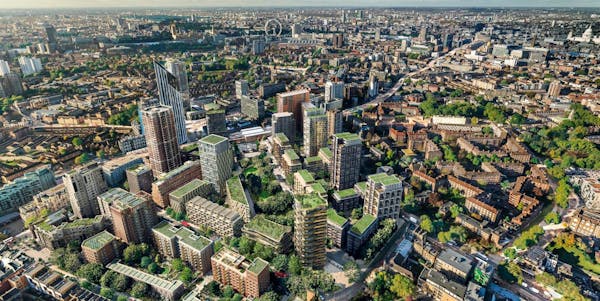The Crown Estate

Latest News

Crown Estate installs urban development delivery chief

Lendlease confirms 'late stage' negotiations for major Crown Estate JV

Allies and Morrison appointed to 'reimagine' iconic West End areas

Crown Estate chooses new chair

The Crown Estate 'reshapes' property teams

Crown Estate sustainability chief to helm UKGBC
About
We are a specialist real estate business with an actively managed portfolio of high-quality assets in great locations.
By combining scale and expertise in our chosen sectors with a customer-focussed approach we deliver strong returns for the nation's finances.
We create brilliant places through conscious commercialism. This means we take a long-term view and consider what we do from every perspective.
Within our Central London portfolio we hold almost the entire freehold to Regent Street and nearly 50 per cent of the buildings in St James's. Across the portfolio we are currently delivering a £1.5 billion investment and redevelopment programme.
Our Central London portfolio includes residential property: our ongoing investment in St James's aims to build on an established and significant residential community, while on Regent Street there are a number of modern apartments for city living.

Although the ownership of some property can be traced back to Edward the Confessor, the estate as a whole essentially dates from 1066.
Despite our modern commercial approach to property management, our history and heritage date back hundreds of years.
Since 1760, the net income of The Crown Estate has been surrendered to the Exchequer by the Monarch under successive Civil List Acts, passed at the beginning of each reign.
The Crown Estate is though owned by the Monarch in right of the Crown. This means that the Queen owns it by virtue of holding the position of reigning Monarch, for as long as she is on the throne, as will her successor. Responsibility for managing The Crown Estate is trusted to us, under the Crown Estate Act, and the Queen is not involved in management decisions.
By contrast, the Queen also has private assets, which include Balmoral and Sandringham, and are hers to deal with as she chooses. But by no means all of what is commonly called Crown Land or Crown Property forms part of The Crown Estate.
In the UK "the Crown" is used not only to describe the Monarch, but also the Executive and the Judiciary. Thus properties owned and managed by Government departments are also Crown Property; these have nothing to do with the funding of the Monarchy or The Crown Estate.
Although the ownership of some property can be traced back to Edward the Confessor, the estate as a whole essentially dates from 1066. After the Norman Conquest, all the land belonged to William "in right of The Crown" because he was King. Despite centuries of change in law and custom, the underlying ownership of The Crown still exists and there is always a presumption in favour of The Crown unless it can be proved that the land belongs to someone else.
The Sovereign's estates had always been used to raise revenue, and over time large areas were granted to nobles. The estate fluctuated in size and value but by 1760, when George III acceded to the throne, the asset had been reduced to a small area producing little income - revenue which George III needed to fulfil the Sovereign's fiscal responsibilities to the nation.
By that time taxes had become the prime source of revenue for the United Kingdom and Parliament administered the country, so an agreement was reached that the Crown Lands would be managed on behalf of the Government and the surplus revenue would go to the Treasury. In return the King would receive a fixed annual payment - formerly known as the Civil List. This agreement has, at the beginning of each reign, been repeated by every succeeding Sovereign. Crown Lands in Scotland were included within the arrangement from 1832.
In 1955 a Government Committee under the Chairmanship of Sir Malcolm Trustram Eve recommended that to avoid confusion between Government property and Crown land, the latter should be renamed The Crown Estate and should be managed by an independent board. These recommendations were implemented by the Crown Estate Acts of 1956 and 1961, which established The Crown Estate as it is today.
Under the Act of 1961, the estate is managed by a Board who have a duty to maintain and enhance the value of the estate and the return obtained from it, but with due regard to the requirements of good management.
In 2011 the Sovereign Grant Act became law. Under the Act The Crown Estate continues to give its entire annual surplus (net profit) to the Treasury. The Act simply provides a mechanism that will be used by the Treasury to determine the amount of Government funding for the Monarch by reference to the amount of our annual surplus.
By combining scale and expertise in our chosen sectors with a customer-focussed approach we deliver strong returns for the nation's finances.
We create brilliant places through conscious commercialism. This means we take a long-term view and consider what we do from every perspective.
Within our Central London portfolio we hold almost the entire freehold to Regent Street and nearly 50 per cent of the buildings in St James's. Across the portfolio we are currently delivering a £1.5 billion investment and redevelopment programme.
Our Central London portfolio includes residential property: our ongoing investment in St James's aims to build on an established and significant residential community, while on Regent Street there are a number of modern apartments for city living.

History
Although the ownership of some property can be traced back to Edward the Confessor, the estate as a whole essentially dates from 1066.
Despite our modern commercial approach to property management, our history and heritage date back hundreds of years.
Since 1760, the net income of The Crown Estate has been surrendered to the Exchequer by the Monarch under successive Civil List Acts, passed at the beginning of each reign.
The Crown Estate is though owned by the Monarch in right of the Crown. This means that the Queen owns it by virtue of holding the position of reigning Monarch, for as long as she is on the throne, as will her successor. Responsibility for managing The Crown Estate is trusted to us, under the Crown Estate Act, and the Queen is not involved in management decisions.
By contrast, the Queen also has private assets, which include Balmoral and Sandringham, and are hers to deal with as she chooses. But by no means all of what is commonly called Crown Land or Crown Property forms part of The Crown Estate.
In the UK "the Crown" is used not only to describe the Monarch, but also the Executive and the Judiciary. Thus properties owned and managed by Government departments are also Crown Property; these have nothing to do with the funding of the Monarchy or The Crown Estate.
Although the ownership of some property can be traced back to Edward the Confessor, the estate as a whole essentially dates from 1066. After the Norman Conquest, all the land belonged to William "in right of The Crown" because he was King. Despite centuries of change in law and custom, the underlying ownership of The Crown still exists and there is always a presumption in favour of The Crown unless it can be proved that the land belongs to someone else.
The Sovereign's estates had always been used to raise revenue, and over time large areas were granted to nobles. The estate fluctuated in size and value but by 1760, when George III acceded to the throne, the asset had been reduced to a small area producing little income - revenue which George III needed to fulfil the Sovereign's fiscal responsibilities to the nation.
By that time taxes had become the prime source of revenue for the United Kingdom and Parliament administered the country, so an agreement was reached that the Crown Lands would be managed on behalf of the Government and the surplus revenue would go to the Treasury. In return the King would receive a fixed annual payment - formerly known as the Civil List. This agreement has, at the beginning of each reign, been repeated by every succeeding Sovereign. Crown Lands in Scotland were included within the arrangement from 1832.
In 1955 a Government Committee under the Chairmanship of Sir Malcolm Trustram Eve recommended that to avoid confusion between Government property and Crown land, the latter should be renamed The Crown Estate and should be managed by an independent board. These recommendations were implemented by the Crown Estate Acts of 1956 and 1961, which established The Crown Estate as it is today.
Under the Act of 1961, the estate is managed by a Board who have a duty to maintain and enhance the value of the estate and the return obtained from it, but with due regard to the requirements of good management.
In 2011 the Sovereign Grant Act became law. Under the Act The Crown Estate continues to give its entire annual surplus (net profit) to the Treasury. The Act simply provides a mechanism that will be used by the Treasury to determine the amount of Government funding for the Monarch by reference to the amount of our annual surplus.
Key People at The Crown Estate
This information is only available to PrimeResi Members...
Join today to enjoy full access to key people, breaking news and the latest luxury property listings.
Already a member? Sign in here.
GET FULL ACCESS NOW
1 St James’s Market London SW1Y 4AH
Locations covered: London Prime Central London Scotland United Kingdom
Latest awards
Create new or manage existing listings via your personal PrimeResi Dashboard
